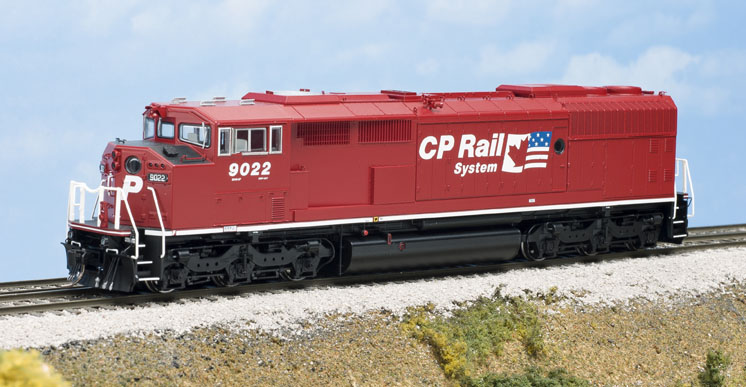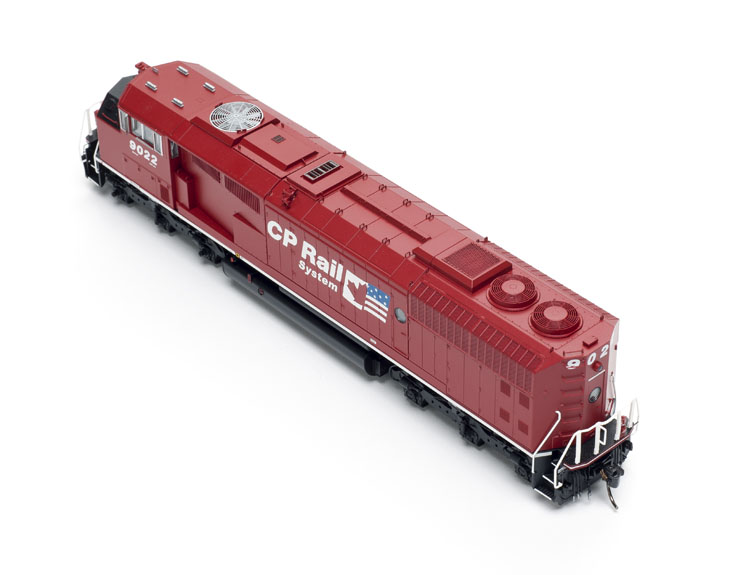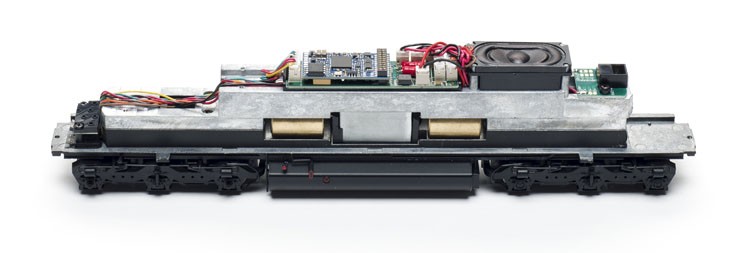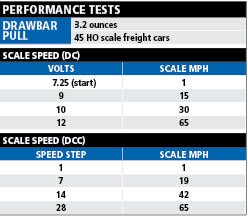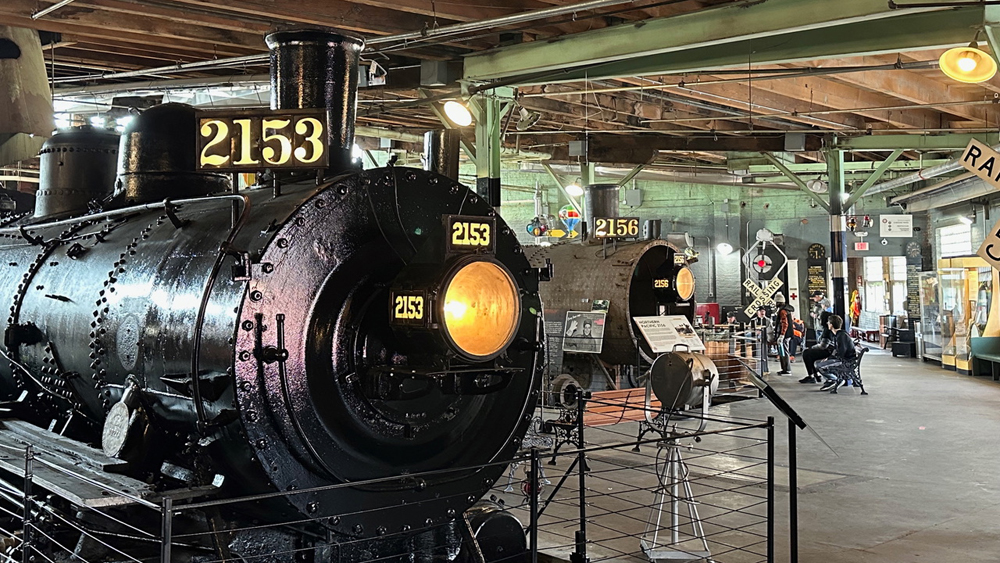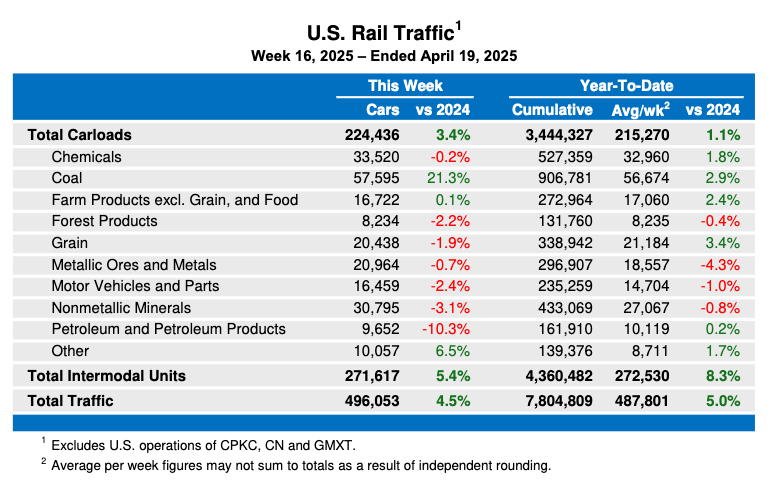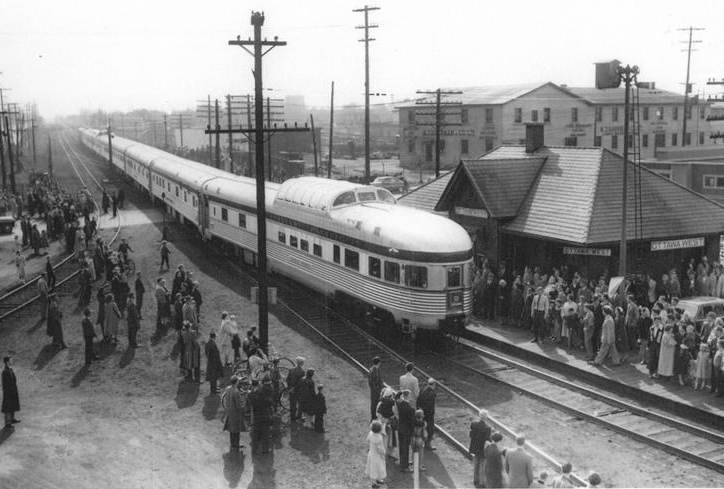For the first time in plastic, a cowl-body SD40-2F rolls along HO scale rails thanks to Bowser Trains. Dubbed “Red Barn” by railfans, the cowl body locomotive is a perfect follow-up to Bowser’s General Motors Diesel Division SD40-2 released last year. (See my review in the July 2016 Model Railroader.) Our review sample came factory-equipped with an ESU LokSound decoder that adds realistic sound to this detailed model on both Digital Command Control (DCC) and direct-current (DC) layouts.
The prototype. In 1988 and 1989 General Motors Diesel Division produced 25 SD40-2F diesel-electric locomotives for CP Rail. Built two years after the last SD40-2s rolled out of Electro-Motive Division’s La Grange, Ill., plant, the Canadian-built SD40-2Fs featured a wide-nose safety cab and a cowl body. These custom-built locomotives marked the last SD40-2 order.
Like other SD40-2s, the heart of the SD40-2F was the 16-cylinder 645 diesel engine that produced 3,000 horsepower. The SD40-2Fs used a Positive Traction Control system, developed by Canadian National and GMDD that was an improvement over the stock EMD anti-wheelslip system.
The SD40-2F fleet soldiered on throughout the 1990s and 2000s. CP Rail started retiring SD40-2Fs in 2012. As of late 2016, all had been removed from the CP Rail roster.
The model. The model’s dimensions match prototype drawings published in the July 1998 Model Railroader, and its details match prototype photos.
The plastic body shell features well-defined molded detail, including grills and engine-access doors on the sides of the body. The body accurately models the “Draper taper” behind the cab that improved rearward visibility for train crews. There’s also tread detail on the front and rear pilot decks. Separate detail parts include m.u. hoses, windshield wipers, and flexible plastic handrails that resist breaking.
The grab irons are wire. The three-chime air horn, bell, and bell bracket are brass parts. The roof-top dynamic brake fans and radiator fans feature see-through grills.
The cab features seats and interior detailing, but no crew figures. All the windows feature clear plastic glazing, including the portholes on the crew doors along the long hood. Our review sample models its prototype as it appeared after 1993, so there’s also a porthole in the front access door. As delivered, this door was blank.
Our review sample, no. 9022, models one of two SD40-2Fs (the other was no. 9000) that got repainted in the CP Rail “dual-flag” paint scheme in 1993. The model is smoothly painted with sharp color separation between the red and black on top of the short hood. The dual-flag logo is clearly printed with no voids in the graphics. Various stencils, including lift here on the jacking pads are legible under magnification. Along with sd40-2f, the CP Rail classification of drf-30y is correctly printed under the road number.
Mechanism. After removing the front and rear coupler draft-gear boxes, I could easily lift off the plastic body shell. The mechanism looks nearly identical to that of Bowser’s earlier model of a standard GMDD SD40-2. The dual-flywheel- equipped motor rests in the center of the metal chassis. Two drive shafts connect the motor to truck-mounted gearboxes.An additional die-cast metal weight runs the length of the locomotive and over the top of the motor.
The ESU LokSound decoder is plugged into a 21-pin socket on the motherboard. Leads run from the motherboard to two lighting boards at each end of the chassis. All lighting is supplied by light-emitting diodes (LEDs). An upward-facing oval speaker is also mounted atop the weight positioned underneath the radiator fans on the body shell.
Performance. As shown in the charts above, the locomotive accelerated smoothly from 1 scale mph to a prototypical 65 scale mph top speed on both our DC and DCC test tracks. The model’s drawbar pull should be enough to handle 45 free-rolling HO scale freight cars on straight and level track.
During the hill climb test, the SD40-2F pulled 10 freight cars up a 3 percent grade without slipping.
All-wheel electrical pickup kept the locomotive rolling smoothly with steady sound and lights. The freely swiveling trucks easily handled 18″ radius curves and no. 5 turnouts.
DCC sound. The ESU LokSound decoder includes the Full Throttle diesel effects package. After pressing function 8 to start the engine sounds, I pressed function 9 (drive/hold) so that I could then use the throttle knob to manually notch the engine before heading down the main line. I then used function 10, the independent brake, to bring the locomotive to a stop.
Other user-triggered effects include the air horn, bell, and coupler sounds. The default horn sound is the correct Nathan K3H. For those who disagree, there are 15 other horns to choose from. The included quick-start guide lists all the available effects and features instructions for setting the volume levels of individual sound effects. A much more extensive user manual is available as a free download at www.esu.com/en/start.
Although the model comes with some pre-programmed momentum, I added more, as well as changed the locomotive address, using an ESU LokProgrammer computer interface (sold separately). The free LokProgrammer software makes it easy to program the indexed CVs required. I find it especially helpful for function mapping.
In addition to the dimmable headlights, I used function 6 to turn on the ditch lights and function 5 to control the classification lights. Just like the prototype, these lights can be set to white, green, red, or off.
I advance-consisted the SD40-2F with a Bowser GMDD SD40-2. The LokSound decoder supports CVs 21 and 22, so I could adjust which effects were controlled by the consist address.
DC sound. Using a DC power pack, the sounds are limited to the diesel engine ramping up and down with the throttle. I appreciated that there was also built-in momentum during DC operation. Sounds also remained constant, even when I flipped the direction switch. The headlights operate according to the locomotive’s direction of travel. However, the ditch lights didn’t come on and the class lights illuminated green in DC. Using a DC sound controller, such as an MRC Tech 6, provides access to all the decoder’s functions in DC and allows some programming.
Superdetailed with super sound, the Bowser SD40-2F is an accurate model of a Canadian classic.
Price: $219.95 (DC no sound), $319.95 (DCC sound)
Manufacturer
Bowser Mfg.
1302 Jordan Ave.
Montoursville, PA 17754
www.bowser-trains.com
Era: 1988 to 2016 (1993 to 2016, as decorated)
Road name: Canadian Pacific (multiple road numbers and paint schemes available)
Features
• 21-pin decoder plug
• All-wheel-drive and electrical pickup
• Die-cast metal frame
• Dual-flywheel-equipped can motor
• ESU LokSound Select decoder
• Kadee metal knuckle couplers at correct height
• Light-emitting-diode headlights, ditch lights, and class lights
• RP-25 contour metal wheels
• Weight: 1 pound, 3.5 ounces





